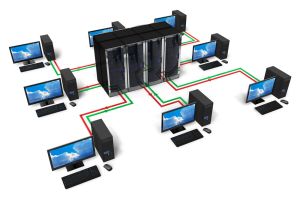Three Critical Infrastructure Elements for Network Uptime
 In today’s fast-paced world, where business is increasingly conducted electronically, infrastructure reliability and network up-time are crucial. Infrastructure weaknesses can lead to network downtime, and outages can prove costly for businesses.
In today’s fast-paced world, where business is increasingly conducted electronically, infrastructure reliability and network up-time are crucial. Infrastructure weaknesses can lead to network downtime, and outages can prove costly for businesses.
Network uptime can be affected by three primary factors. Focusing on adding redundancy to these three elements can help ensure network reliability and decrease the likelihood of an outage.
Overheating
Servers, like any piece of equipment, have the potential to overheat if proper steps are not taken to control their temperature. Servers typically run uninterrupted, unlike desktop PCs that are powered down, or go into idle mode throughout the day. Servers also are often housed in small rooms, and in close quarters with other network equipment. These server rooms can quickly warm to levels that can jeopardize equipment.
Whether a business is housing its own equipment, or outsourcing network and server functions to a third party or cloud provider, it is critical to ensure that network infrastructure is properly cooled. At least two cooling methods should be employed to ensure there is a backup in case one cooling method fails. Possible cooling solutions include rooftop air conditioning units, external condensers, and computer room air conditioning units.
Power Failures
Sometimes the most obvious point of weakness is the most overlooked. Infrastructure equipment requires power to function, and reliable data center power with a backup power solution for redundancy is critical.
An A+B power feed, which creates two independent channels from the public power source to the infrastructure equipment, should be at the top of the requirement list for data center power. This eliminates potential single points of failure when power channels are shared at any point.
Some of the power options that can be included in each feed are uninterruptible power supply, utility power, back-up generator, maintenance bypass panel, internal server power, mains distribution panel, and an automatic transfer switch. Each power feed should have at least one of these options, and should be able to handle the entire server load at peak usage independently to create redundancy.
Network Connections
The equipment used to connect infrastructure to the Internet is another potential point of weakness. Routers and switches wear out relatively quickly, and should be properly maintained and replaced in a timely manner. Integrating backup connections to create redundancy can help prevent network downtime. In addition, connections from the data center to the external Internet network are crucial for network uptime. Peering arrangements with multiple connections create redundancy and reliability, and can optimize performance.
Another important key to making sure potential network failure is mitigated is to choose network and infrastructure providers that are committed to reducing or eliminating single points of failure by adding backups and redundancies. Network downtime is costly and unacceptable, but there are simple ways to build in redundancy. Cutting corners on infrastructure reliability leads to network downtime and service interruptions that can ultimately cost more than building redundancy in from outset.
